人教高中英语必修4 Unit 4 Body language Warming up & Reading (共20张PPT)
文档属性
| 名称 | 人教高中英语必修4 Unit 4 Body language Warming up & Reading (共20张PPT) | 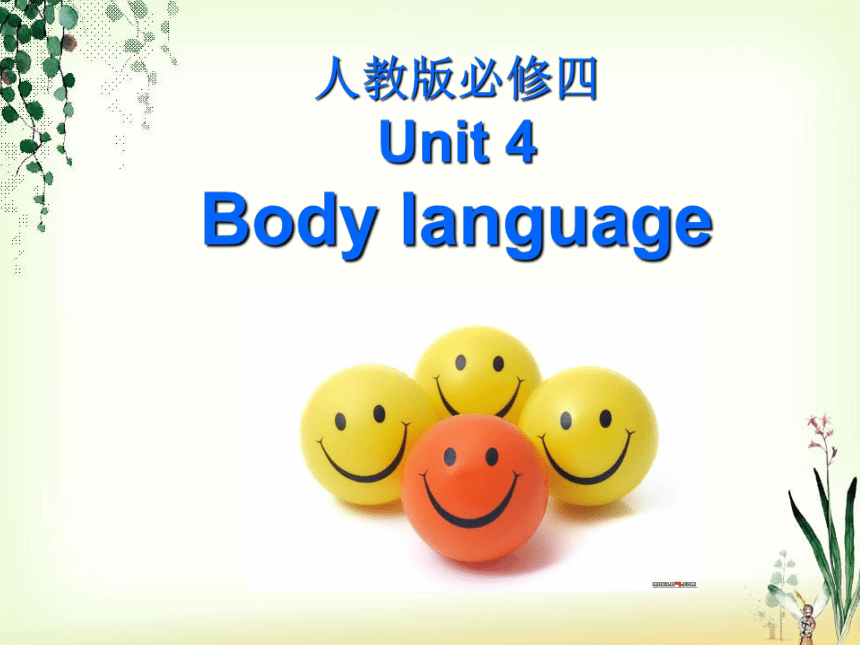 | |
| 格式 | zip | ||
| 文件大小 | 1.2MB | ||
| 资源类型 | 教案 | ||
| 版本资源 | 人教版(新课程标准) | ||
| 科目 | 英语 | ||
| 更新时间 | 2020-06-13 15:08:24 | ||
图片预览

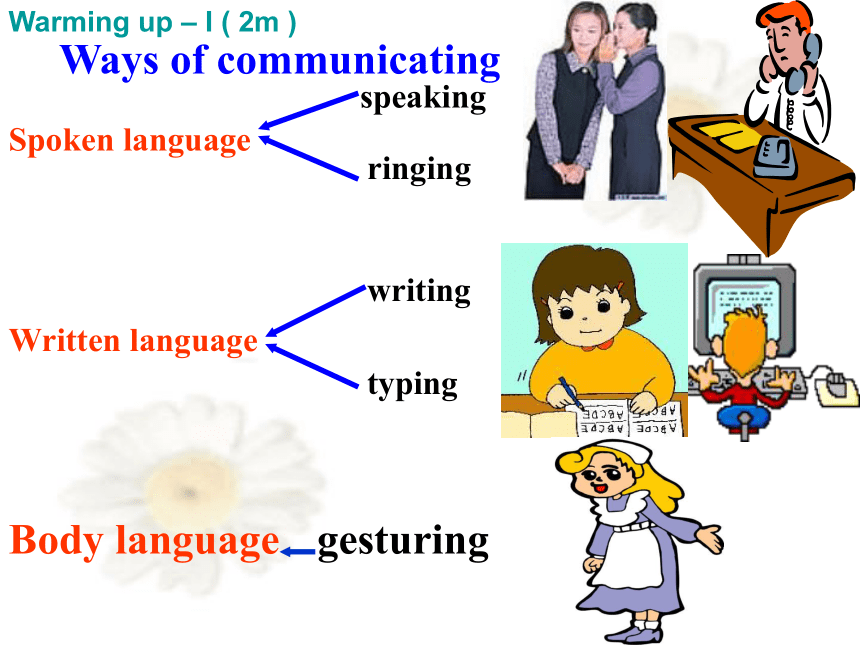
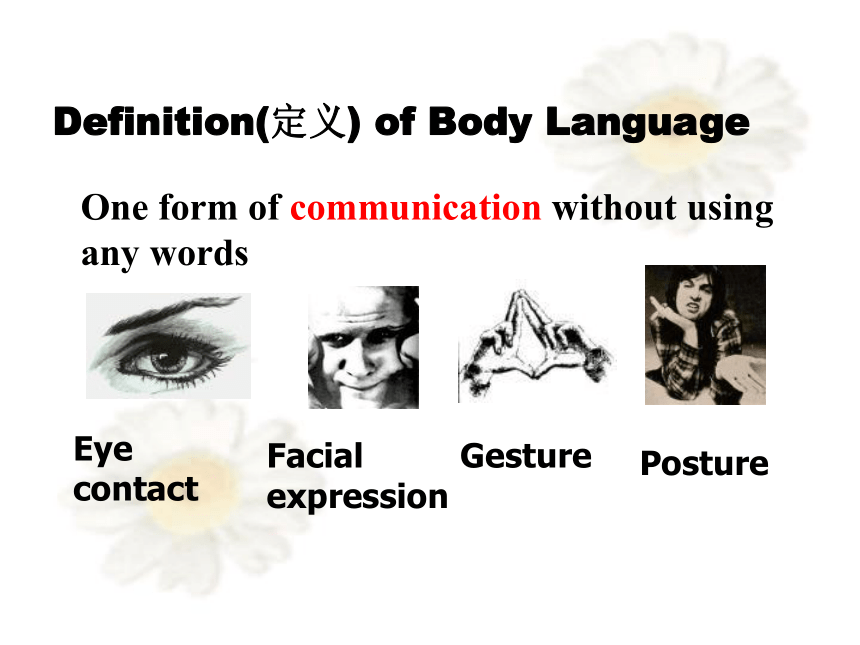
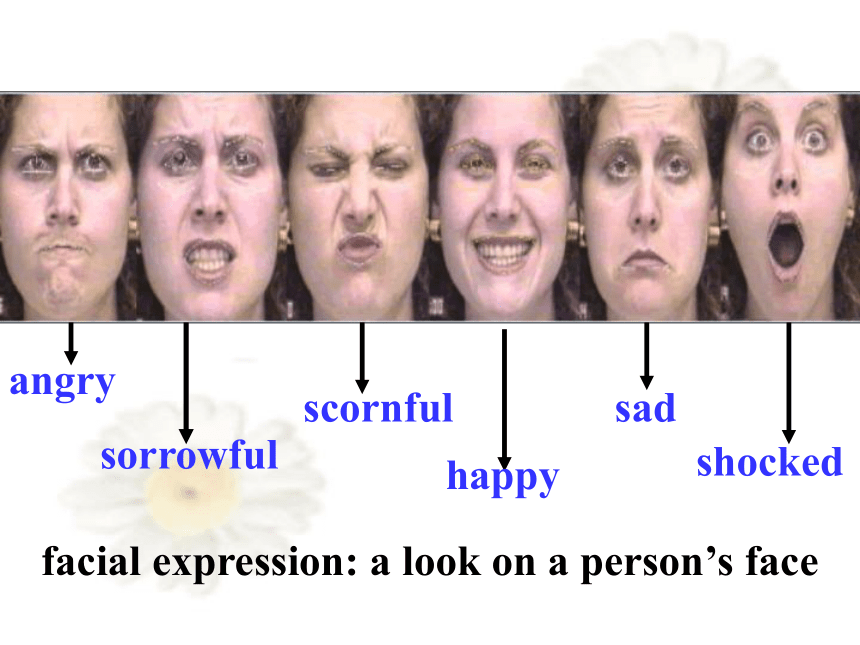
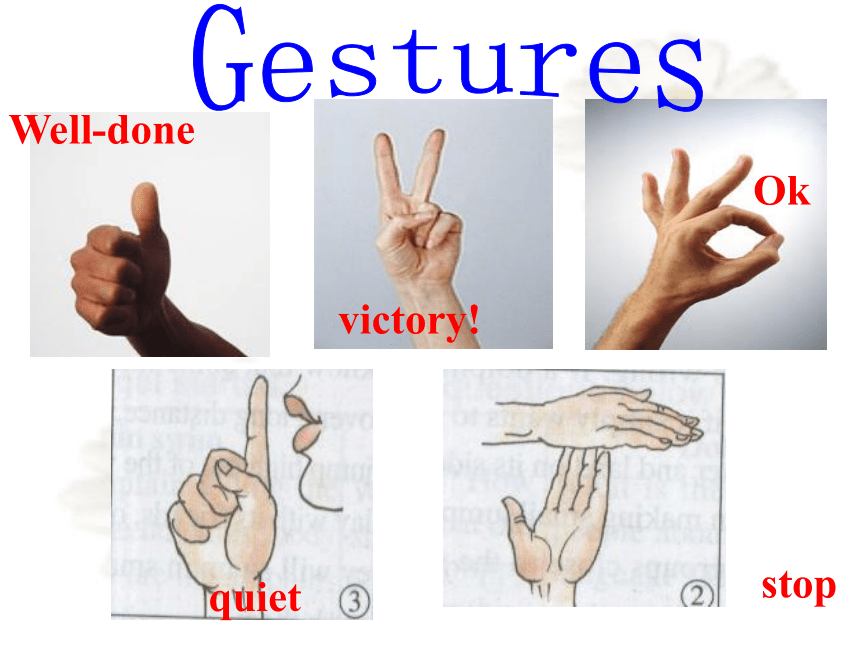
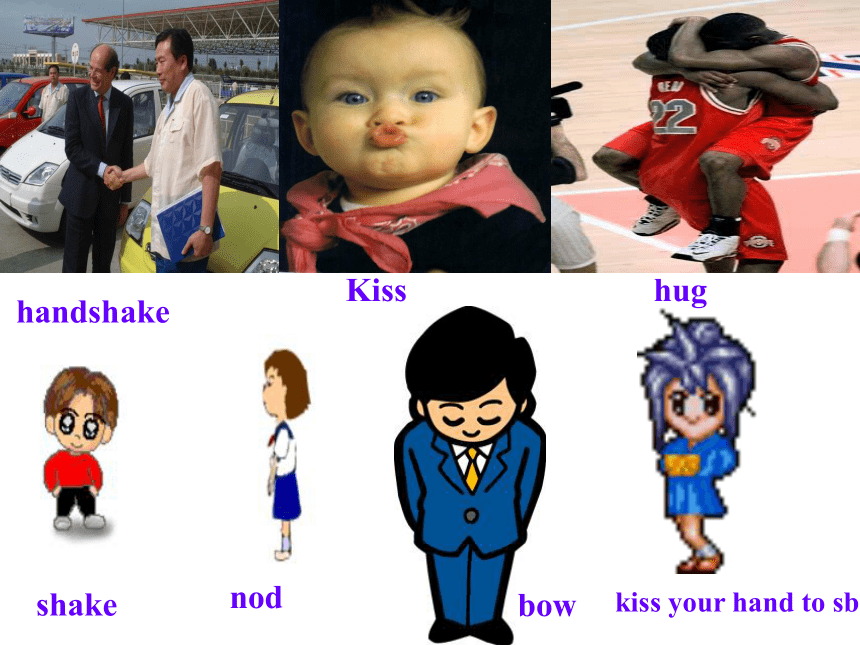
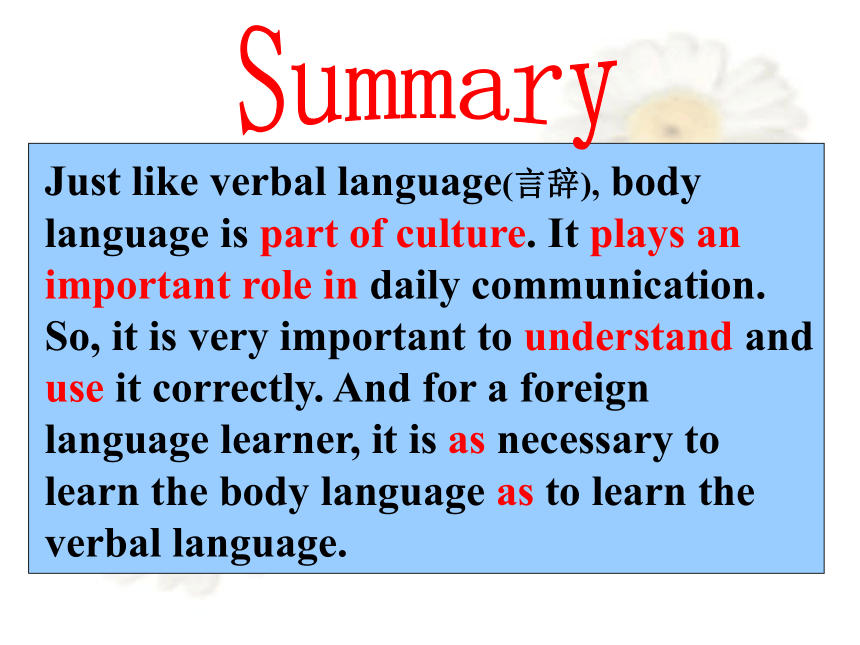
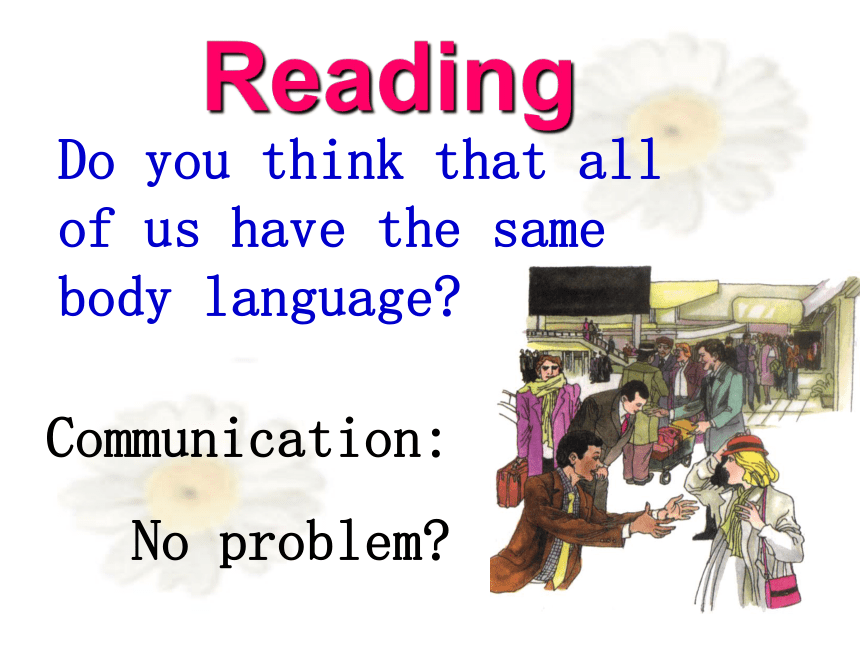
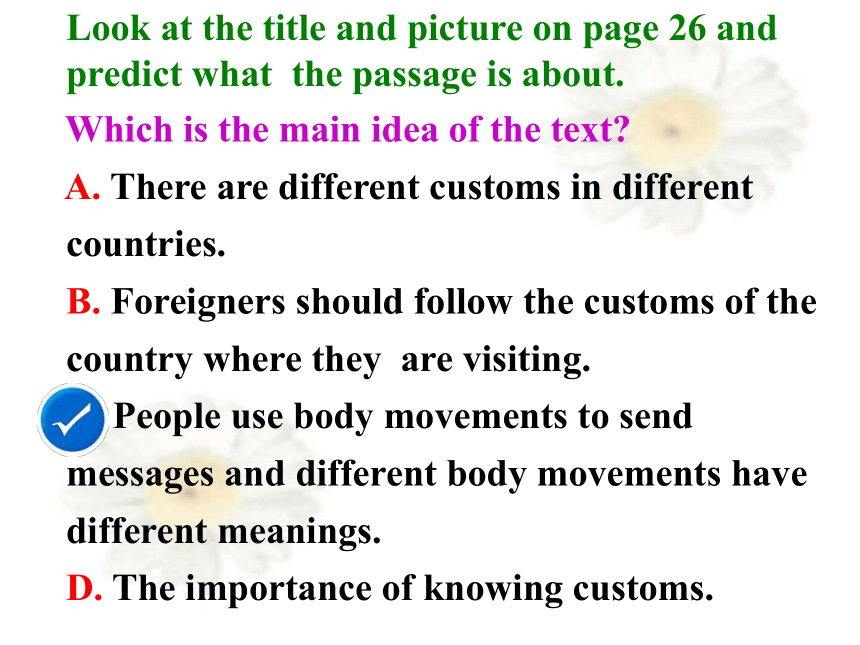
文档简介
(共20张PPT)
WELCOME
Body
language
Unit
4
人教版必修四
Unit
4
Body
language
speaking
ringing
writing
typing
Spoken
language
Written
language
Body
language
Ways
of
communicating
gesturing
Warming
up
–
I
(
2m
)
Definition(定义)
of
Body
Language
One
form
of
communication
without
using
any
words
Eye
contact
Facial
expression
Gesture
Posture
angry
sorrowful
scornful
happy
sad
shocked
facial
expression:
a
look
on
a
person’s
face
Well-done
Ok
stop
quiet
Gestures
victory!
handshake
Kiss
hug
shake
nod
bow
kiss
your
hand
to
sb.
Summary
Just
like
verbal
language(言辞),
body
language
is
part
of
culture.
It
plays
an
important
role
in
daily
communication.
So,
it
is
very
important
to
understand
and
use
it
correctly.
And
for
a
foreign
language
learner,
it
is
as
necessary
to
learn
the
body
language
as
to
learn
the
verbal
language.
Reading
Communication:
No
problem?
Do
you
think
that
all
of
us
have
the
same
body
language?
Look
at
the
title
and
picture
on
page
26
and
predict
what
the
passage
is
about.
Which
is
the
main
idea
of
the
text?
A.
There
are
different
customs
in
different
countries.
B.
Foreigners
should
follow
the
customs
of
the
country
where
they
are
visiting.
C.
People
use
body
movements
to
send
messages
and
different
body
movements
have
different
meanings.
D.
The
importance
of
knowing
customs.
(Para.1)
(Para.
2~3)
(Para.
4)
(Para.
5)
Different
people
have
different
body
language.
Meet
the
visitors
at
the
airport.
Summary
of
body
language.
Match
the
main
idea
of
each
part
with
lines.
Part
1.
Part
2.
Part
3.
Part
4.
People
from
different
countries
express
greetings
in
different
ways.
Careful
reading
para1
Judge
the
following
sentences
T
or
F
1.
Yesterday,
another
student
and
I,
representing
our
university's
student
association,
went
to
the
Capital
International
Airport
to
meet
this
year's
international
students.
2.
After
an
hour
of
waiting
for
their
flight
to
arrive,
I
saw
several
young
people
enter
the
waiting
area
looking
around
curiously.
3.
I
stood
for
a
minute
watching
them
and
then
went
to
greet
them.
T
F
T
Character
Country
Mr.
Garcia
Britain
Mr.
Cook
A
Japanese
Japan
Jordan
Madame
Coulon
The
author
Julia
Smith
Columbia
Canada
Ahmed
Aziz
France
China
Do
you
know
the
characters?
Mr
Garcia
(Columbia)
Julia
Smith
(Britain)
Visitor
(Japan)
George
Cook
(Canada)
Madame
Coulon
(France)
Matching
the
people
and
their
different
ways
of
greeting
(para2&3)
shakes
hands
and
kisses
others
twice
on
each
cheek
bows
shakes
hands
approaches
others
closely
and
touches
their
shoulder
and
kisses
them
on
the
cheek
does
not
stand
very
close
to
others
or
touch
strangers
Part
2
Find
out
the
two
mistakes
the
writer
found
in
the
airport:
Mr.
Garcia
Julia
Smith
The
first
mistake
from
from
(Columbia
)
(Britain)
He
approaches
Ms
Smith
by
_______
______
_________
and
_______
her
on
the
________.
She
______
________
appearing
_________
and
take
a
few
steps
_______
______
Mr.
Garcia.
shoulder
touching
her
kissed
cheek
stepped
back
surprised
away
from
Para
2
The
second
mistake
a
Japanese
George
Cook
from
(Canada)
He
________
________
_______
________
to
the
Japanese.
He
________
to
Mr.
Cook
and
his
nose
_________
Mr.
Cook’s
_______
________.
bowed
touched
moving
hand
reached
his
hand
out
Para4
?
__I
get
to
know
more
international
friends,
I
learn
more
about
this
cultural
"body
language".
________cultures
greet
each
other
the
same
way,
______are
they
comfortable
in
the
same
way
with
touching
or
distance
between
people.
In
the
same
way
that
people
communicate
with_______________,
they
also
express
their
feelings
__________unspoken
"language"
__________physical
distance,
actions
or
posture.
English
people,
for
example,
do
not
usually
stand
very
close
to
others
or
touch
strangers
as
soon
as
they
meet.
However,
people
from
places
like
Spain,
Italy
or
South
American
countries
___________others
closely
and
are
more
_____to
touch
them.
Most
people
around
the
world
now
greet
each
other
by_______________,
but
some
cultures
use
other
greetings________,
such
as
the
Japanese,
who
prefer
to
bow.
As
Not
all
nor
spoken
language
using/by
through
approach
likely
shaking
hands
as
well
Different
countries
have
___________(不同)cultures,
so
when
people
greet
each
other,
they
will
have
different_______(方式).
If
people
don’t
know
the
cultural
differences
well,
people
may
have
difficulties
in________________(交流)
with
others
throughout
the
world.
Conclusion
different
approaches
communicating
I,
togother
with
another
student,
went
to
Capital
International
Airport
to
meet
some___________students
from
many
parts
of
the
world.
They
arrived
and
entered
the
waiting
area
looking
around
________.
The
first
one
to
arrive
is
Mr.
Garcia
from
Columbia
with
Julia
Smith,
a
British
lady,
__________behind
closely.
I
________them
to
each
other
and
I’m
_________to
see
Mr.
Garcia
come
up
to
Ms
Smith.
Just
then,
in
comes
a
visitor
from
Japan,
smiling
at
the
time
when
the
Canadian,
Gorge
Cook
__________out
his
hand
to
him.
international
curiously
following
introduce
surprised
reaches
Text
retelling:
It
happens
that
Mr
Cook’s
hand
__________
the
Japanese’s
nose
as
he
bows
and
they
both________
So
you
see,
people
from
_________
cultures
maynot
_______others
in
the
same
way.
English
people
usually
do
not
_______very
close
to
others
or
touch
the
________as
people
from
Spain,
Italy
and
South
American
countries
do.
Most
People
around
the
world
_________hands
when
they
meet
while____________people
will
bow..
touches
apologize
different
greet
stand
strangers
shake
Japanese
People
from
Jodan
stand
quiet
______to
other
men
and
shake
hands
and
will
usually
not
touch
________.
In
a
word,
body
language
differs
in
different
cultures
and
is
widely
used
in_____________.
close
women
communication
WELCOME
Body
language
Unit
4
人教版必修四
Unit
4
Body
language
speaking
ringing
writing
typing
Spoken
language
Written
language
Body
language
Ways
of
communicating
gesturing
Warming
up
–
I
(
2m
)
Definition(定义)
of
Body
Language
One
form
of
communication
without
using
any
words
Eye
contact
Facial
expression
Gesture
Posture
angry
sorrowful
scornful
happy
sad
shocked
facial
expression:
a
look
on
a
person’s
face
Well-done
Ok
stop
quiet
Gestures
victory!
handshake
Kiss
hug
shake
nod
bow
kiss
your
hand
to
sb.
Summary
Just
like
verbal
language(言辞),
body
language
is
part
of
culture.
It
plays
an
important
role
in
daily
communication.
So,
it
is
very
important
to
understand
and
use
it
correctly.
And
for
a
foreign
language
learner,
it
is
as
necessary
to
learn
the
body
language
as
to
learn
the
verbal
language.
Reading
Communication:
No
problem?
Do
you
think
that
all
of
us
have
the
same
body
language?
Look
at
the
title
and
picture
on
page
26
and
predict
what
the
passage
is
about.
Which
is
the
main
idea
of
the
text?
A.
There
are
different
customs
in
different
countries.
B.
Foreigners
should
follow
the
customs
of
the
country
where
they
are
visiting.
C.
People
use
body
movements
to
send
messages
and
different
body
movements
have
different
meanings.
D.
The
importance
of
knowing
customs.
(Para.1)
(Para.
2~3)
(Para.
4)
(Para.
5)
Different
people
have
different
body
language.
Meet
the
visitors
at
the
airport.
Summary
of
body
language.
Match
the
main
idea
of
each
part
with
lines.
Part
1.
Part
2.
Part
3.
Part
4.
People
from
different
countries
express
greetings
in
different
ways.
Careful
reading
para1
Judge
the
following
sentences
T
or
F
1.
Yesterday,
another
student
and
I,
representing
our
university's
student
association,
went
to
the
Capital
International
Airport
to
meet
this
year's
international
students.
2.
After
an
hour
of
waiting
for
their
flight
to
arrive,
I
saw
several
young
people
enter
the
waiting
area
looking
around
curiously.
3.
I
stood
for
a
minute
watching
them
and
then
went
to
greet
them.
T
F
T
Character
Country
Mr.
Garcia
Britain
Mr.
Cook
A
Japanese
Japan
Jordan
Madame
Coulon
The
author
Julia
Smith
Columbia
Canada
Ahmed
Aziz
France
China
Do
you
know
the
characters?
Mr
Garcia
(Columbia)
Julia
Smith
(Britain)
Visitor
(Japan)
George
Cook
(Canada)
Madame
Coulon
(France)
Matching
the
people
and
their
different
ways
of
greeting
(para2&3)
shakes
hands
and
kisses
others
twice
on
each
cheek
bows
shakes
hands
approaches
others
closely
and
touches
their
shoulder
and
kisses
them
on
the
cheek
does
not
stand
very
close
to
others
or
touch
strangers
Part
2
Find
out
the
two
mistakes
the
writer
found
in
the
airport:
Mr.
Garcia
Julia
Smith
The
first
mistake
from
from
(Columbia
)
(Britain)
He
approaches
Ms
Smith
by
_______
______
_________
and
_______
her
on
the
________.
She
______
________
appearing
_________
and
take
a
few
steps
_______
______
Mr.
Garcia.
shoulder
touching
her
kissed
cheek
stepped
back
surprised
away
from
Para
2
The
second
mistake
a
Japanese
George
Cook
from
(Canada)
He
________
________
_______
________
to
the
Japanese.
He
________
to
Mr.
Cook
and
his
nose
_________
Mr.
Cook’s
_______
________.
bowed
touched
moving
hand
reached
his
hand
out
Para4
?
__I
get
to
know
more
international
friends,
I
learn
more
about
this
cultural
"body
language".
________cultures
greet
each
other
the
same
way,
______are
they
comfortable
in
the
same
way
with
touching
or
distance
between
people.
In
the
same
way
that
people
communicate
with_______________,
they
also
express
their
feelings
__________unspoken
"language"
__________physical
distance,
actions
or
posture.
English
people,
for
example,
do
not
usually
stand
very
close
to
others
or
touch
strangers
as
soon
as
they
meet.
However,
people
from
places
like
Spain,
Italy
or
South
American
countries
___________others
closely
and
are
more
_____to
touch
them.
Most
people
around
the
world
now
greet
each
other
by_______________,
but
some
cultures
use
other
greetings________,
such
as
the
Japanese,
who
prefer
to
bow.
As
Not
all
nor
spoken
language
using/by
through
approach
likely
shaking
hands
as
well
Different
countries
have
___________(不同)cultures,
so
when
people
greet
each
other,
they
will
have
different_______(方式).
If
people
don’t
know
the
cultural
differences
well,
people
may
have
difficulties
in________________(交流)
with
others
throughout
the
world.
Conclusion
different
approaches
communicating
I,
togother
with
another
student,
went
to
Capital
International
Airport
to
meet
some___________students
from
many
parts
of
the
world.
They
arrived
and
entered
the
waiting
area
looking
around
________.
The
first
one
to
arrive
is
Mr.
Garcia
from
Columbia
with
Julia
Smith,
a
British
lady,
__________behind
closely.
I
________them
to
each
other
and
I’m
_________to
see
Mr.
Garcia
come
up
to
Ms
Smith.
Just
then,
in
comes
a
visitor
from
Japan,
smiling
at
the
time
when
the
Canadian,
Gorge
Cook
__________out
his
hand
to
him.
international
curiously
following
introduce
surprised
reaches
Text
retelling:
It
happens
that
Mr
Cook’s
hand
__________
the
Japanese’s
nose
as
he
bows
and
they
both________
So
you
see,
people
from
_________
cultures
maynot
_______others
in
the
same
way.
English
people
usually
do
not
_______very
close
to
others
or
touch
the
________as
people
from
Spain,
Italy
and
South
American
countries
do.
Most
People
around
the
world
_________hands
when
they
meet
while____________people
will
bow..
touches
apologize
different
greet
stand
strangers
shake
Japanese
People
from
Jodan
stand
quiet
______to
other
men
and
shake
hands
and
will
usually
not
touch
________.
In
a
word,
body
language
differs
in
different
cultures
and
is
widely
used
in_____________.
close
women
communication
同课章节目录
